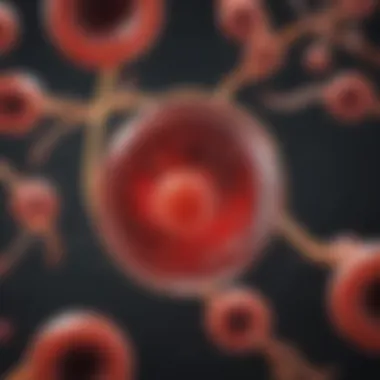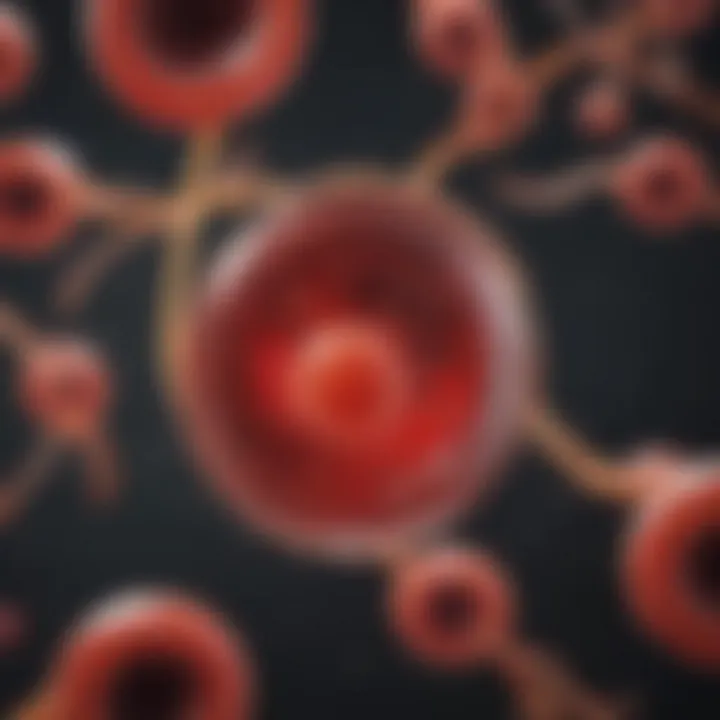Cord Blood and Leukemia: Unraveling Their Connection


Intro
The interplay between cord blood and leukemia represents a significant area of exploration within medical research. Cord blood, which is the blood collected from the umbilical cord and placenta post-delivery, is a rich source of stem cells. These stem cells have therapeutic potential, particularly in hematological conditions like leukemia. This article will delve into how cord blood can play a crucial role in understanding and treating leukemia, alongside the advancements and challenges faced by researchers and medical practitioners in this domain.
Research Overview
Examining the relationship between cord blood and leukemia involves a comprehensive analysis of key findings in the literature, as well as study methodologies adopted by clinical practitioners and researchers.
Key Findings
- Cord Blood Stem Cells: Cord blood is particularly useful due to its higher concentration of hematopoietic stem cells compared to adult bone marrow. These cells can differentiate into various types of blood cells, making them essential in treating blood-related disorders.
- Transplantation Success: Studies have shown that cord blood transplants can be less prone to graft-versus-host disease, a common complication in traditional stem cell transplants. This makes cord blood a viable option for patients with leukemia.
- Ongoing Research: Researchers are continually exploring the immunological properties of cord blood stem cells, which may enhance the effectiveness of leukemia treatment protocols.
Study Methodology
Research in this area typically employs diverse methodologies, including:
- Clinical Trials: Many investigations are conducted in clinical settings, allowing researchers to assess the efficacy and safety of cord blood stem cells in real-world scenarios.
- Laboratory Studies: Preclinical studies in vitro (in labs) and in vivo (in animal models) help elucidate the mechanisms by which cord blood can combat leukemia.
- Meta-Analyses: Reviews of existing studies provide insights into patterns and outcomes associated with cord blood use in leukemia therapies.
Background and Context
The relationship between cord blood and leukemia requires understanding historical and current trends that have shaped research in this area.
Historical Background
The use of cord blood in medicine began gaining attention in the late 20th century. Early transplants showcased its potential, particularly for treating various blood disorders. Initial skepticism about the efficacy of cord blood stem cells has gradually shifted towards recognition of their utility in acute leukemias, evidenced by successful transplant cases.
Current Trends in the Field
Currently, the medical landscape is witnessing several important trends:
- Increased Storage: The practice of storing cord blood is becoming more common, allowing families to access this valuable resource when needed.
- Expanding Indications: Beyond leukemia, research is expanding into other hematological conditions where cord blood might prove beneficial.
- Innovative Treatments: Developments in precision medicine are paving the way for more tailored therapeutic approaches using cord blood, enhancing patient outcomes.
"The exploration into cord blood usage marks a pivotal advancement in leukemia treatment, bridging gaps between past apprehensions and future potential.”
As this field continues to evolve, it remains critical for researchers, healthcare providers, and patients alike to stay updated on developments that promise to enhance treatment outcomes for leukemia and related conditions.
Intro to Cord Blood and Leukemia
The exploration of cord blood and its relationship to leukemia holds significant importance in both medical and scientific communities. Cord blood, the blood found in the umbilical cord after childbirth, is a valuable source of hematopoietic stem cells. These stem cells have the unique ability to develop into different types of blood cells. This characteristic positions cord blood as a potential treatment for various hematological disorders, including leukemia.
Leukemia itself is a complex disease that arises from the uncontrolled proliferation of abnormal blood cells. This complexity makes therapeutic strategies both crucial and challenging. By analyzing the connection between cord blood and leukemia, one can appreciate the therapeutic possibilities that arise from this unique cellular resource. For patients and families impacted by leukemia, understanding these connections can illuminate potential avenues for treatment and recovery.
Defining Cord Blood
Cord blood is collected at the time of delivery and is often discarded unless specifically harvested for medical use. This blood contains a high concentration of stem cells, particularly hematopoietic stem cells, which are essential for blood formation. Unlike adult stem cells, these cells possess greater plasticity and replication capacity. This means they can be more effective in regenerating a healthy blood supply when transplanted into a patient with leukemia or other blood disorders.
Storing cord blood in a bank allows for future use, making it a critical resource for not only immediate family members, but potentially for other patients in need. The rise of cord blood banking reflects a growing recognition of the significance of this resource in regenerative medicine.
Understanding Leukemia
Leukemia is classified into several types based on the speed of progression and the specific type of blood cells affected. Broadly, it can be categorized as either acute or chronic, with each type presenting distinct characteristics and treatment challenges.
Acute leukemia, which progresses rapidly, often necessitates immediate intervention. In contrast, chronic leukemia progresses more slowly and may not require immediate treatment. Despite these differences, all forms of leukemia result in the overproduction of dysfunctional white blood cells, which inhibit the body’s ability to produce healthy blood cells.
Understanding leukemia at a cellular level reveals the mechanisms by which this disease disrupts normal hematopoiesis—a process that becomes increasingly relevant as researchers explore targeted therapies, particularly involving cord blood.
"The interplay between cord blood and leukemia treatment is a fundamental area of research, suggesting fresh perspectives in therapeutic approaches."
As we proceed to examine the types of leukemia and how they relate to cord blood therapies, it is crucial to keep in mind the overarching goal of improving patient outcomes—a vital endeavor for any treatment paradigm.


Types of Leukemia and Their Characteristics
Understanding types of leukemia is crucial in the context of cord blood therapies. Each type of leukemia presents unique characteristics and challenges that influence treatment approaches. The specificity of leukemia types guides medical professionals in selecting appropriate therapeutic strategies, including the use of cord blood stem cells.
Key considerations about types of leukemia include:
- Histological classification: Different types of leukemia arise from various cell types and stages of differentiation.
- Patient demographics: Age, genetics, and environmental factors influence the prevalence of certain types of leukemia.
- Treatment Response: Knowledge of specific leukemia types determines how patients might respond to therapies, including stem cell transplants.
In the following sections, we will examine three prominent types of leukemia: acute lymphoblastic leukemia, chronic myeloid leukemia, and acute myeloid leukemia.
Acute Lymphoblastic Leukemia
Acute lymphoblastic leukemia, often abbreviated as ALL, primarily affects lymphoid cells. It is most common in children but can also occur in adults. The rapid proliferation of immature lymphocytes can disrupt normal blood cell production, leading to various health complications. Symptoms include fatigue, fever, and easy bruising or bleeding.
The treatment for ALL typically involves chemotherapy and may include the use of cord blood stem cells. Research indicates that allogeneic cord blood transplants can improve outcomes for patients who do not respond well to conventional therapies. Cord blood offers a rich source of hematopoietic stem cells, which can help restore normal blood cell production.
Chronic Myeloid Leukemia
Chronic myeloid leukemia, known as CML, usually progresses slowly compared to other leukemia types. It primarily affects adults and occurs due to a genetic mutation that results in the overproduction of myeloid cells. CML has three phases: chronic, accelerated, and blast crisis, with each requiring different therapeutic strategies.
Targeted therapies, such as tyrosine kinase inhibitors, are commonly used for CML. However, in cases of transformation to blast crisis, more aggressive treatments, including stem cell transplantation, may be necessary. Research into cord blood as a viable source for hematopoietic stem cells is ongoing, aiming to improve outcomes for CML patients undergoing transplantation.
Acute Myeloid Leukemia
Acute myeloid leukemia, referred to as AML, is a fast-growing form of leukemia that affects myeloid cells. It's more common in older adults but can occur at any age. The disease presents with symptoms such as anemia, frequent infections, and bleeding. Rapid diagnosis and treatment are critical, as AML can progress quickly.
Treatment generally consists of intensive chemotherapy followed by consolidation therapy. For some AML patients, especially those with high-risk features, cord blood stem cell transplants are being explored as a treatment option. Cord blood can provide a source of matched stem cells, which may benefit patients who lack suitable unrelated donors.
"The potential for cord blood in leukemia therapies remains an area of significant research, offering hope to many patients facing life-threatening conditions."
In summation, understanding the characteristics of different types of leukemia is an essential step in the continuum of care. Each type poses its own unique challenges but also opens avenues for innovative treatments like those using cord blood stem cells.
Stem Cells: The Basis of Cord Blood Therapy
In understanding the connection between cord blood and leukemia, it is crucial to explore the role of stem cells. Stem cells are unique in their ability to differentiate into various types of cells, which makes them a powerful tool in medical therapies. This section delves into the significance of stem cells within the context of cord blood therapy, examining their types, functions, and the advantages they provide in treating leukemia.
What Are Stem Cells?
Stem cells are undifferentiated cells capable of self-renewal and differentiation into specialized cell types. They can be categorized primarily into two types: embryonic stem cells and adult stem cells. Adult stem cells exist in specific tissues and maintain the ability to regenerate and repair; they are often referred to as somatic stem cells.
These cells have immense therapeutic potential due to their capacity to develop into any cell type in the body. The most relevant type for hematological conditions like leukemia is the hematopoietic stem cell. These hematopoietic stem cells are responsible for producing all types of blood cells, including red blood cells, white blood cells, and platelets. Their role in replenishing blood cells is critical in the treatment of disorders like leukemia, where bone marrow function is compromised.
Hematopoietic Stem Cells in Cord Blood
Hematopoietic stem cells are abundant in cord blood, a rich source collected from the umbilical cord and placenta after birth. This collection is non-invasive and safe for both mother and child, providing a unique opportunity to obtain stem cells without ethical concerns associated with other sources.
The utilization of hematopoietic stem cells from cord blood has several benefits:
- Less stringent matching: The immune system of newborns is not fully developed, which allows for more flexibility in matching donors with recipients. This feature increases the chance of finding a suitable match for patients needing transplants.
- Reduced risk of graft-versus-host disease: When using cord blood, the likelihood of this complication, where the transplanted immune cells attack the host's body, is considerably lower compared to traditional bone marrow transplants.
- Rapid availability: Cord blood can be processed and stored in cord blood banks immediately after collection, making it more readily available when needed for treatment.
"The use of hematopoietic stem cells from cord blood offers immense potential for treating leukemia, providing options that can improve patient outcomes."
In light of these advantages, researchers are actively investigating the full extent of cord blood therapy's potential in leukemia treatment. The ongoing developments underline the importance of understanding stem cell properties, as these cells form the core of innovative therapies aiming to combat leukemia and related blood disorders.
Mechanisms of Action in Leukemia Treatment
Understanding the mechanisms of action in leukemia treatment is essential for deciphering how therapies can effectively combat this complex disease. By exploring how cord blood stem cells interact with leukemia at a cellular level, we uncover potential benefits and considerations that can impact treatment outcomes.
Cord blood contains a rich source of hematopoietic stem cells, which have distinct properties that make them suitable for leukemia treatment. These mechanisms not only include restoring the normal production of blood cells but also involve modulating the immune response against malignant cells. Below, we explore the specific actions of cord blood stem cells in targeting leukemia and the immunological effects of cord blood transplantation on patient health.
How Cord Blood Stem Cells Target Leukemia


Cord blood stem cells specifically target leukemia through several pathways. One of the primary mechanisms is through hematopoiesis, where the stem cells differentiate into healthy blood cells. This process is crucial for re-establishing normal blood cell populations in patients who have undergone aggressive therapies such as chemotherapy or radiation, which often lead to reduced blood cell counts.
Additionally, the unique immunological properties of cord blood stem cells allow them to help in reducing leukemia cell populations. This occurs through a process known as graft-versus-leukemia (GVL) effect. Here, the transplanted stem cells recognize and attack the residual leukemic cells in the patient’s body. While this response can be beneficial, it is necessary to monitor the balance between effective leukemia targeting and potential graft-versus-host disease, which occurs when the donated stem cells attack the patient’s healthy tissues.
In summary, the targeting mechanisms of cord blood stem cells involve:
- Re-establishing normal blood cell production.
- Inducing an immune response against leukemia cells via graft-versus-leukemia effect.
- Potential risks related to graft-versus-host disease.
Immunological Effects of Cord Blood Transplantation
The immunological impacts of cord blood transplantation are vital for understanding treatment outcomes for leukemia patients. When cord blood is transplanted, it not only replaces damaged or diseased stem cells but also introduces a fresh immune system that can be crucial in fighting leukemia.
The fresh immune cells can mount an effective response against the cancer cells. This is particularly important because residual leukemia cells often evade the existing immune response after initial treatments.
Some key immunological effects of cord blood transplantation include:
- Enhanced immune surveillance: Cord blood stem cells boost the immune system's ability to identify and eliminate leukemic cells.
- Cytokine production: The interaction between transplanted cells and existing immune cells can stimulate the production of cytokines, which are critical in signaling and coordinating the immune response.
- Increased diversity of immune cells: The infancy of the immune system in cord blood translates to a wide variety of immune cells, leading to a more adaptable response to different leukemia types.
"Cord blood transplantation provides not just a source of healthy cells but also a potential reset of the immune system, enabling a stronger defense against leukemia."
Clinical Applications of Cord Blood in Treating Leukemia
The significance of cord blood in the treatment of leukemia cannot be understated. As a source of hematopoietic stem cells, cord blood has opened new avenues for therapeutic strategies. These stem cells possess unique qualities that allow them to develop into different blood cells. This versatility is critical in addressing the various forms of leukemia, which are characterized by abnormal blood cell proliferation.
Current Clinical Practices
In recent years, the use of cord blood for transplantations has gained traction in clinical settings. Hospitals now routinely consider cord blood as a viable option for patients suffering from leukemia. The procedure generally involves collecting cord blood immediately after childbirth. This blood is then processed and either stored for future use or used immediately for transplant.
- Hematopoietic Stem Cell Transplants: Cord blood stem cell transplants have been successful in treating various leukemia types, particularly acute lymphoblastic leukemia. This success has prompted many transplant centers to establish dedicated cord blood banks, ensuring swift availability for patients.
- Less Graft-Versus-Host Disease: An important advantage of using cord blood is the lower incidence of graft-versus-host disease (GVHD). In GVHD, the donor cells attack the patient’s tissues. Cord blood cells often show lower immunogenicity, leading to fewer complications.
- Diverse Donor Pool: Cord blood banks also promote diversity in transplantation. The availability of multiple cord blood units increases the chances of finding a suitable match for patients from various ethnic backgrounds.
Clinical trials have documented the effectiveness of cord blood therapies. Many studies show improved patient survival rates. This has led to increased interest among researchers to explore cord blood as an effective treatment option.
Case Studies and Patient Outcomes
Research in clinical applications often includes tangible outcomes, which can provide invaluable insights into the efficacy of treatments. Various case studies demonstrate encouraging results from patients treated with cord blood.
- Case Study 1: A young patient with acute myeloid leukemia (AML) received a cord blood transplant. Post-transplant assessments indicated a significant reduction in blast cells, which are indicative of leukemia. The patient has been in remission for over two years.
- Case Study 2: An adult patient with chronic lymphocytic leukemia (CLL) benefited from cord blood-derived stem cells. This case highlighted the effectiveness of the transplant in managing symptoms and enhancing life quality. The patient reported fewer negative side effects compared to traditional chemotherapy.
- Longitudinal Studies: Long-term follow-ups have become a critical aspect of assessing patient outcomes. Ongoing studies reveal that several patients remain disease-free a number of years post-transplant, showcasing the potential of cord blood in long-term management.
"The use of cord blood for treating leukemia has revolutionized the approach, providing hope where traditional methods faltered."
Given these promising results, healthcare professionals are encouraged to consider cord blood treatments as a frontline option in leukemia therapy. As research continues to unfold, we may see even broader applications and improved protocols that further enhance patient outcomes.
Ethical and Legal Considerations
The topic of ethical and legal considerations in cord blood and leukemia is crucial for ensuring the responsible use of stem cell therapies. As the medical community moves towards innovative treatments using cord blood stem cells, various ethical dilemmas and legal frameworks must be addressed. This discussion focuses on the regulations surrounding cord blood banking and the significance of informed consent in stem cell research.
Cord Blood Banking Regulations
Cord blood banking involves collecting and preserving umbilical cord blood, rich in hematopoietic stem cells. These cells have potential applications in treating leukemia among other diseases. However, the process is governed by strict regulations to ensure safety, efficacy, and ethical practices.
In the United States, the Food and Drug Administration (FDA) oversees cord blood banking through regulations. These rules intend to protect donors and recipients while maintaining high quality in the collection and storage processes. For example, banks must adhere to stringent standards for testing the cord blood for infectious diseases. They should also implement protocols to ensure proper handling and storage, minimizing the risk of contamination or degradation over time.
Some banks operate as public entities, collecting donations and facilitating transplants for those in need. Others function as private banks, allowing families to preserve cord blood exclusively for personal use. Both models present unique considerations related to access, equity, and the potential commercialization of stem cells.
On an international scale, regulations vary greatly. Countries such as Canada and those in Europe have their own sets of guidelines concerning cord blood collection, processing, and ethical implications surrounding donations.
Informed Consent in Stem Cell Research
Informed consent is pivotal in the ethical landscape of stem cell research and therapy. It refers to obtaining voluntary agreement from donors after providing sufficient information about the nature, risks, and benefits of the procedure. In the context of cord blood banking, this process is especially significant.


Donors need to comprehend what donating cord blood entails. This includes understanding how their samples will be used, potential risks involved, and how it might affect their family members. Additionally, donors should be informed about the possible limitations of using stored cord blood, especially concerning specific medical conditions like leukemia.
Moreover, researchers have an obligation to safeguard the privacy and integrity of donor information. This practice not only underscores ethical considerations but builds trust between the medical community and participants. Transparency in research methodologies and outcomes is also essential.
Ethical guidelines push the boundaries of how we view consent and donor autonomy, shaping the landscape for future research in stem cell therapies.
Challenges in Research and Treatment
The challenges in research and treatment regarding cord blood and leukemia present significant barriers in translating scientific advancements into clinical practice. These challenges include issues related to the availability and accessibility of cord blood, as well as the variability in treatment responses among patients. Addressing these obstacles is critical for enhancing the efficacy of cord blood therapies in leukemia treatment and ensuring more patients can benefit from these potential interventions.
Availability and Accessibility of Cord Blood
Cord blood is a valuable source of hematopoietic stem cells, yet its availability poses a fundamental challenge. The collection and storage of cord blood often rely on the willingness of parents to donate. Moreover, not all hospitals have the facilities required to process and store the blood correctly, limiting access for some families.
- Banking Options: Public cord blood banks offer donation opportunities that are used for transplant needs, while private banks allow families to store their own child's cord blood for future use. The decision-making process can be complex and influenced by personal, ethical, and financial considerations.
- Geographic Disparities: Accessibility varies widely based on geographic location. Families in rural areas might find it harder to access banking services compared to urban counterparts. This disparity can significantly impact treatment options when leukemia arises.
Efforts to increase awareness and increase public cord blood donation are essential. Enhanced education can lead to more families considering donation, thus increasing the availability of this resource for future leukemia patients.
Heterogeneity in Leukemia Treatment Responses
The responses of leukemia patients to treatment, including those involving cord blood, can vary drastically. This variability is known as heterogeneity and arises from several factors that complicate treatment outcomes.
- Biological Differences: Patient-specific factors such as age, genetics, and underlying health conditions can affect how their body responds to treatments. For instance, younger patients may tolerate certain therapies better than older counterparts.
- Differences in Leukemia Subtypes: Leukemia encompasses various subtypes, each with unique characteristics and behaviors. Treatments that may work well for one type might not yield the same effectiveness for another. This complexity necessitates personalized treatment strategies that consider the specific nuances of each patient's disease.
- Immune Response: The immune system plays a crucial role in fighting leukemia. Variabilities in patients' immune systems can lead to different treatment responses, including those utilizing cord blood stem cells.
"Personalized approaches in medicine are not only beneficial but necessary due to the diversity of patient responses to treatments."
To improve outcomes, research must continue to identify biological markers that could predict how individual patients respond to specific therapies, including cord blood treatments. By understanding and anticipating these differences, healthcare teams can tailor interventions that enhance overall efficacy.
Future Directions in Cord Blood Research
The exploration of future directions in cord blood research is critical to understanding how this resource can be utilized more effectively in the context of leukemia treatment. Recent advancements in medical science and technology make it imperative to investigate the potential role of cord blood stem cells in therapeutic applications. By doing so, researchers aim to uncover innovative methods that can enhance treatment outcomes for leukemia patients.
Innovations in Stem Cell Therapies
Research in stem cell therapies is at a critical juncture. Significant efforts have been directed toward improving the efficacy of cord blood stem cell transplantation. These innovations include better methods for processing cord blood, enhancing the engraftment of stem cells, and optimizing conditioning regimens used prior to transplantation. One such development is the utilization of novel umbilical cord blood units that show a greater capacity for engraftment. Research also explores modifying the behavioral characteristics of stem cells to enhance their anti-cancer effects.
Moreover, the development of combination therapies incorporating cord blood cells with existing chemotherapy drugs is being evaluated. The objective is to both reduce toxicity and improve patient outcomes. Cord blood cells can potentially augment the immune response against leukemic cells,making them a valuable addition to established treatment protocols.
Emerging Technologies and Their Implications
Advancements in biotechnology directly impact the future of cord blood research. Techniques such as CRISPR gene editing open new avenues for modifying stem cells to better target malignancies like leukemia. This technology can be used for creating genetically modified stem cells that have enhanced capabilities to attack cancer cells. Also, artificial intelligence is now being employed to analyze large datasets related to cord blood stem cell therapies and patient responses. This can drive personalized medicine strategies, optimizing treatment based on individual patient profiles.
Biobanking is evolving too, where sophisticated storage solutions maintain the viability of stem cells for longer periods. This can extend the potential for future uses, ensuring that quality cord blood samples are available for unforeseen medical needs.
"As we look towards the future, the potential of cord blood in treating leukemia becomes increasingly evident, underscoring the need for sustained research and investment."
Research in this field stands to not only improve existing therapies but also pave the way for entirely new treatment modalities that can transform patient care.
Finale: The Potential of Cord Blood in Leukemia
The exploration of cord blood in relation to leukemia presents significant implications for future treatment modalities. Cord blood is a rich source of hematopoietic stem cells, which possess the unique ability to develop into various blood cell types. This characteristic is particularly beneficial in the context of leukemia, where restoring healthy blood cell production is crucial. Not only does it offer potential therapeutic solutions, but it also opens up avenues for innovative research that may redefine treatment approaches.
Summary of Findings
Research indicates that cord blood stem cells can effectively combat the effects of leukemia and enhance patient outcomes. Several key findings include:
- Stem Cell Versatility: Cord blood contains hematopoietic stem cells, which are essential in restoring the blood system in leukemia patients.
- Reduced Graft Versus Host Disease: Transplants involving cord blood have shown a lower incidence of graft-versus-host disease compared to other sources of stem cells, leading to improved patient safety and comfort.
- Immunological Advantages: The immunological properties of cord blood stem cells can be harnessed to target leukemia cells, offering a dual approach to treatment.
These findings collectively highlight the potential of cord blood as a viable and effective option for managing and treating leukemia, signifying an important advancement in the field.
Final Thoughts on Future Research
The field of cord blood research related to leukemia is still evolving, with much potential for growth. Key considerations for future research may include:
- Improved Banking Techniques: Developing better techniques to preserve and expand cord blood stem cells can increase the availability of these cells for treatment.
- Tailored Treatments: Future studies should focus on personalized approaches in using cord blood for different types of leukemia, considering the unique genetic and immunological profiles of patients.
- Long-term Outcomes: It is essential to investigate the long-term impacts of cord blood transplantation on leukemia survival rates and quality of life across diverse patient demographics.
As the understanding of cord blood's role in leukemia deepens, its integration into clinical practice may offer new hope for patients and families affected by this serious condition. Taking these steps in research can help build a comprehensive framework for effectively utilizing cord blood in leukemia treatment.







